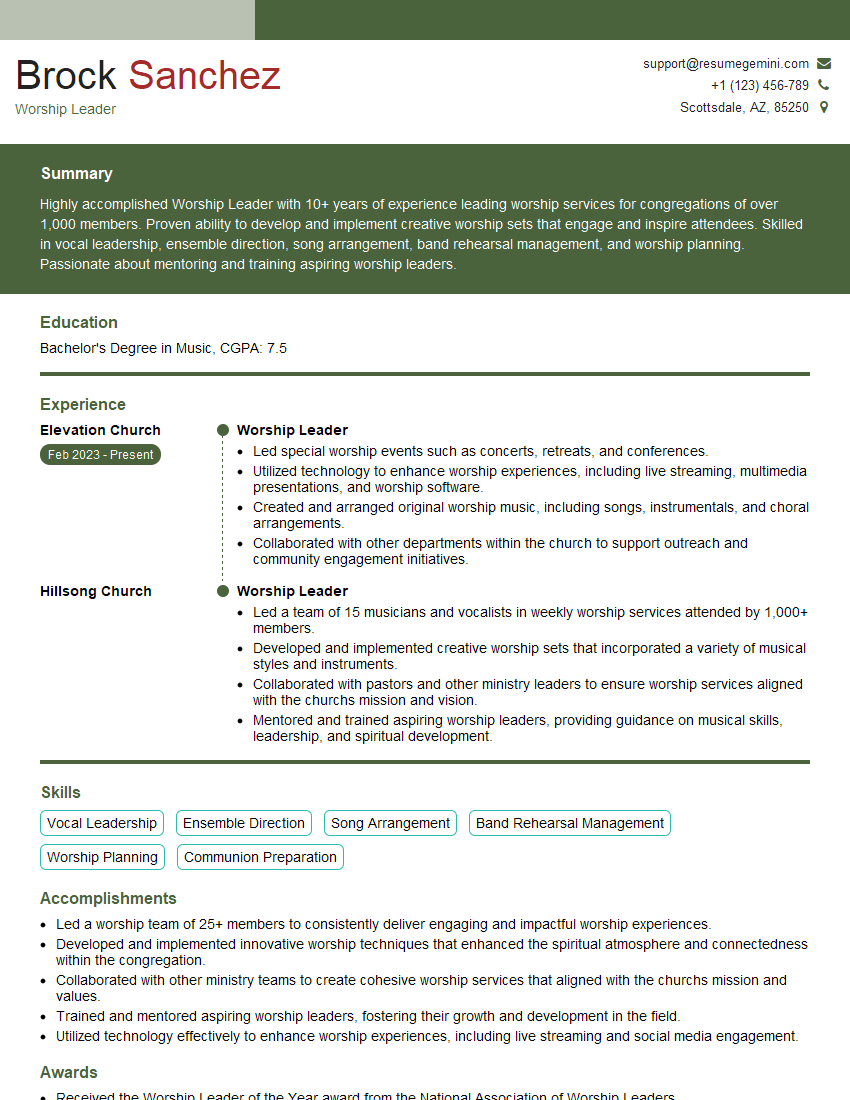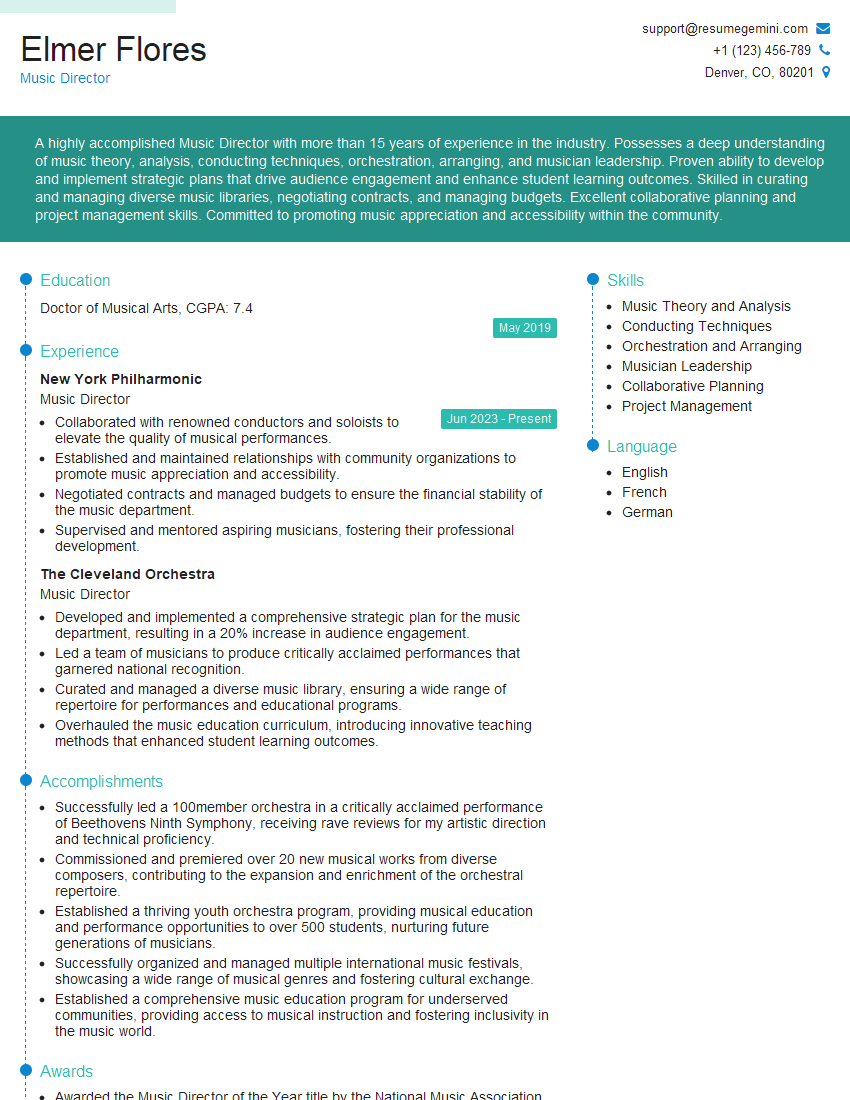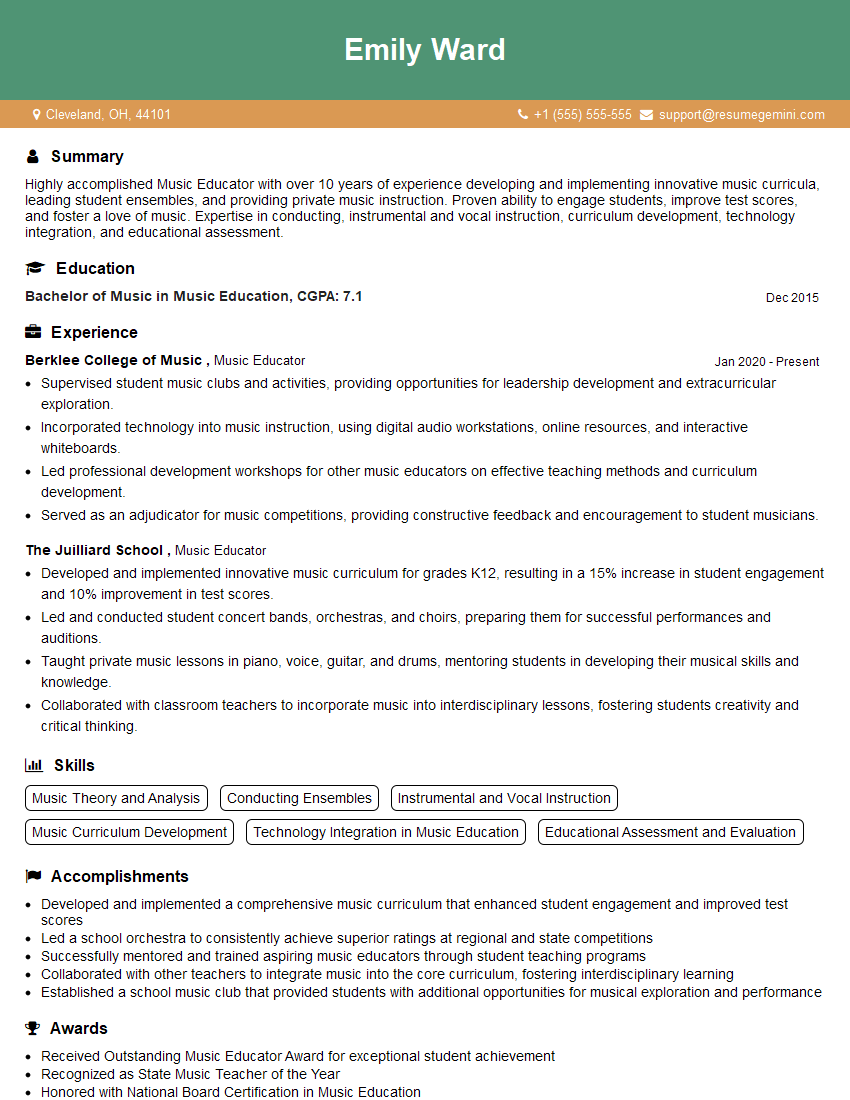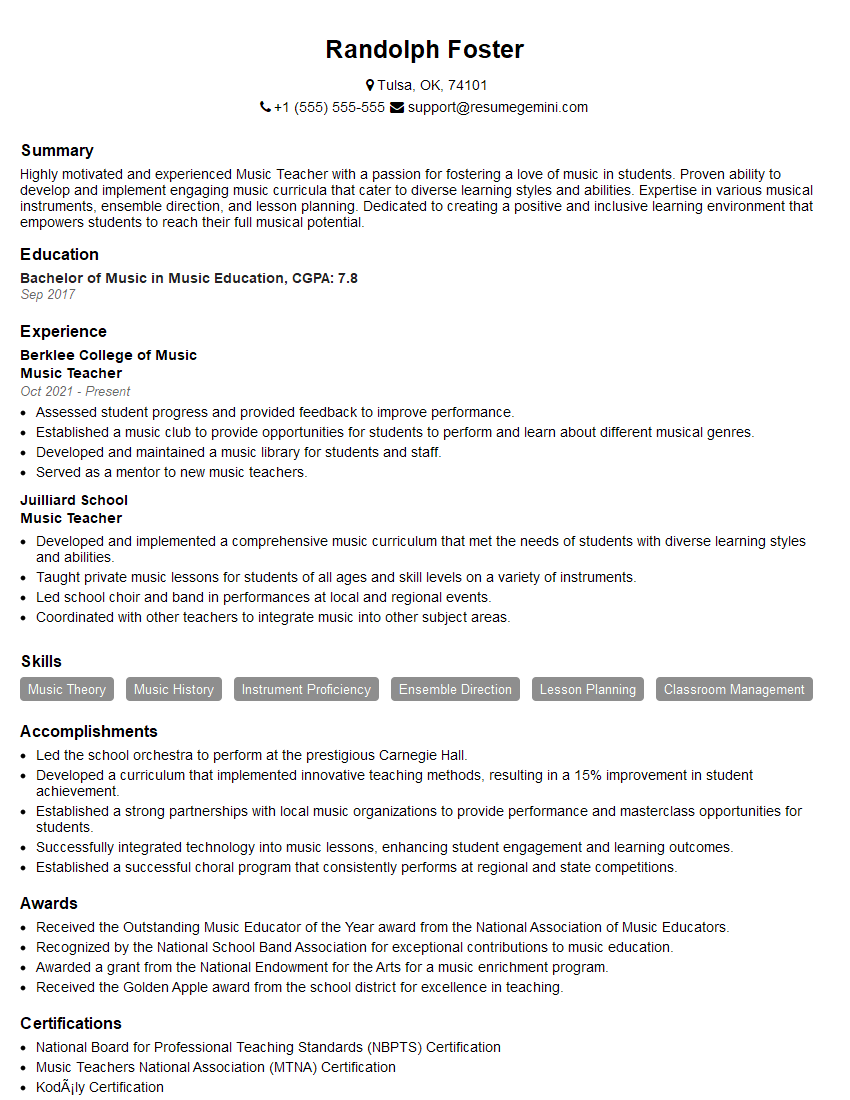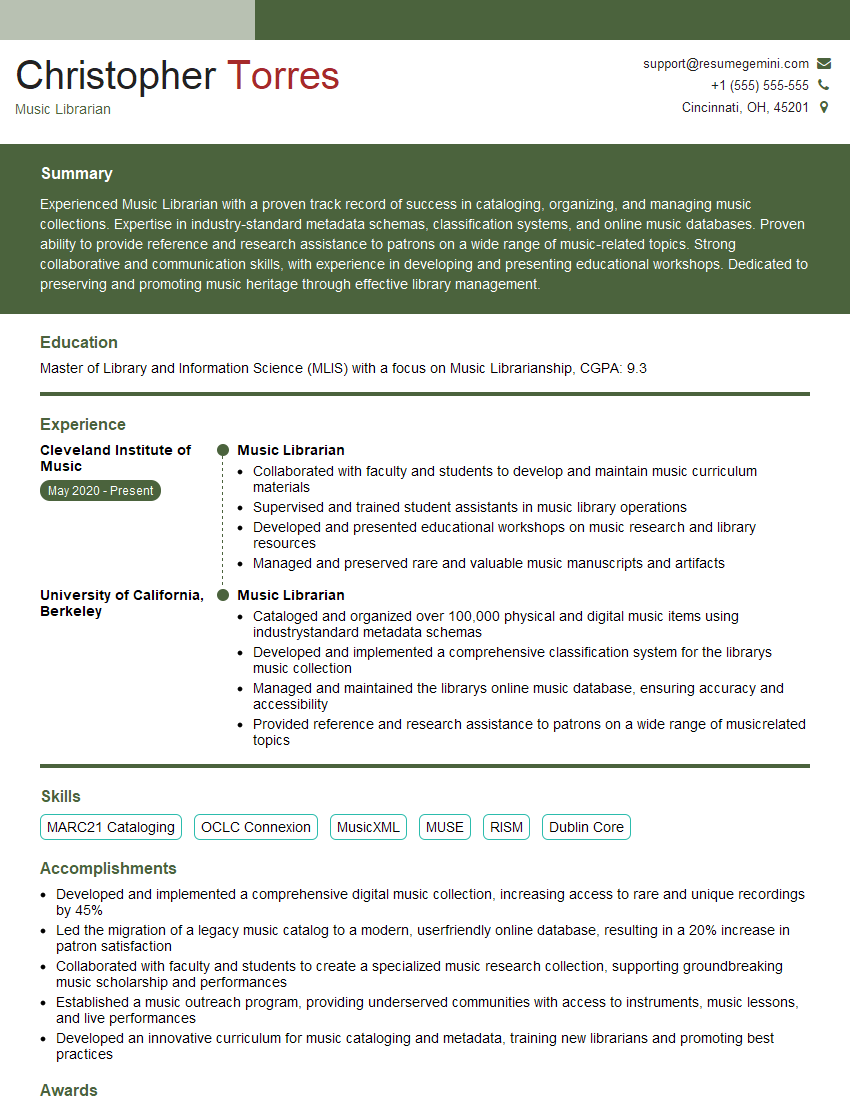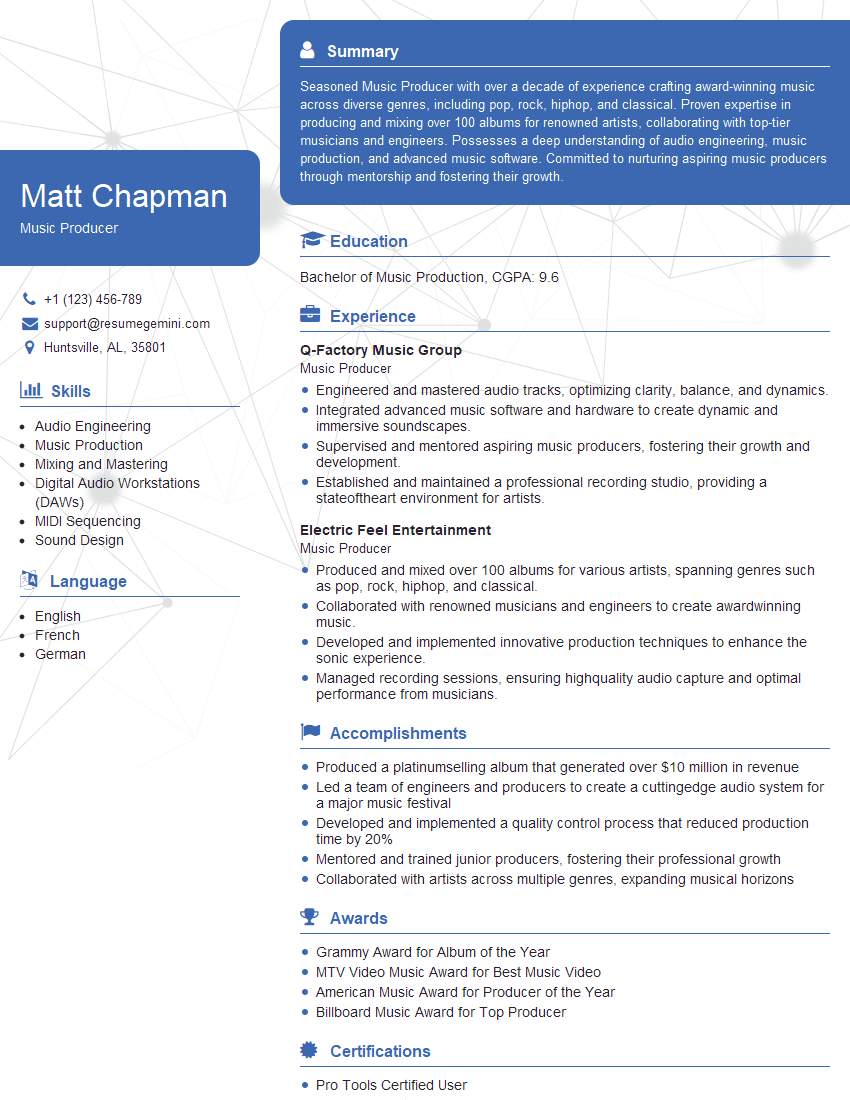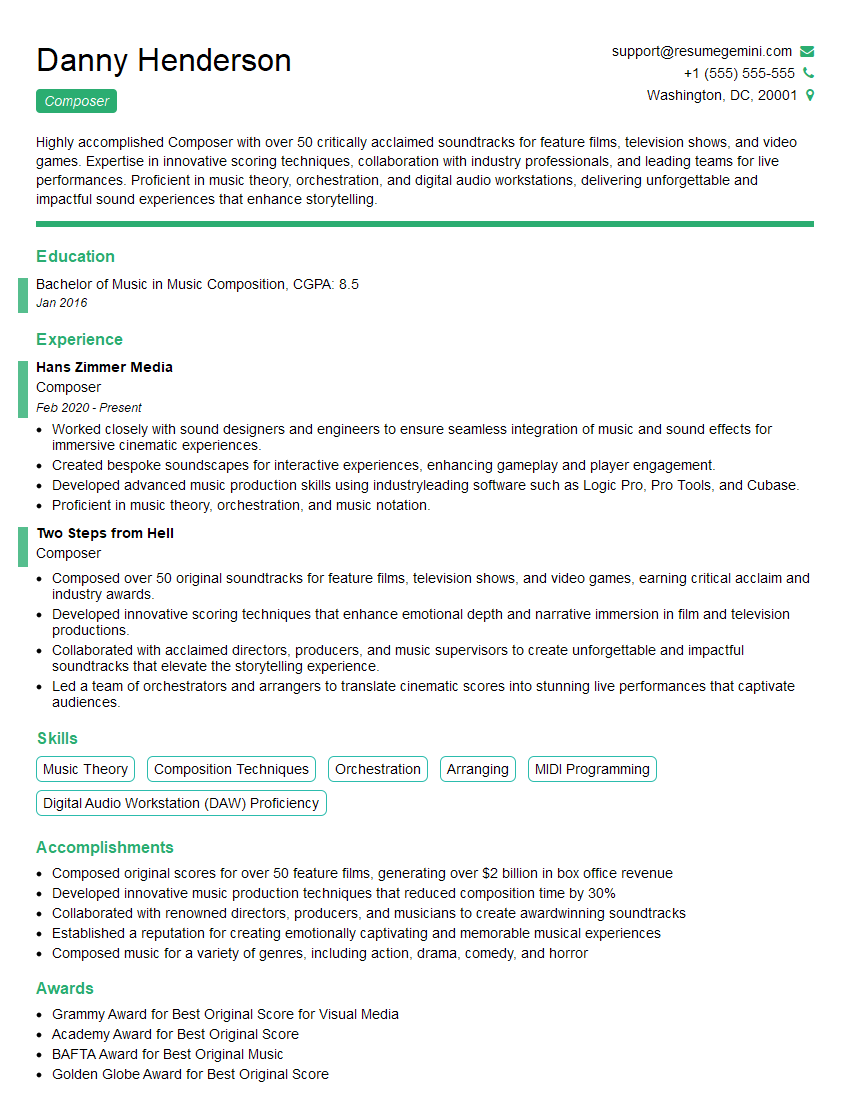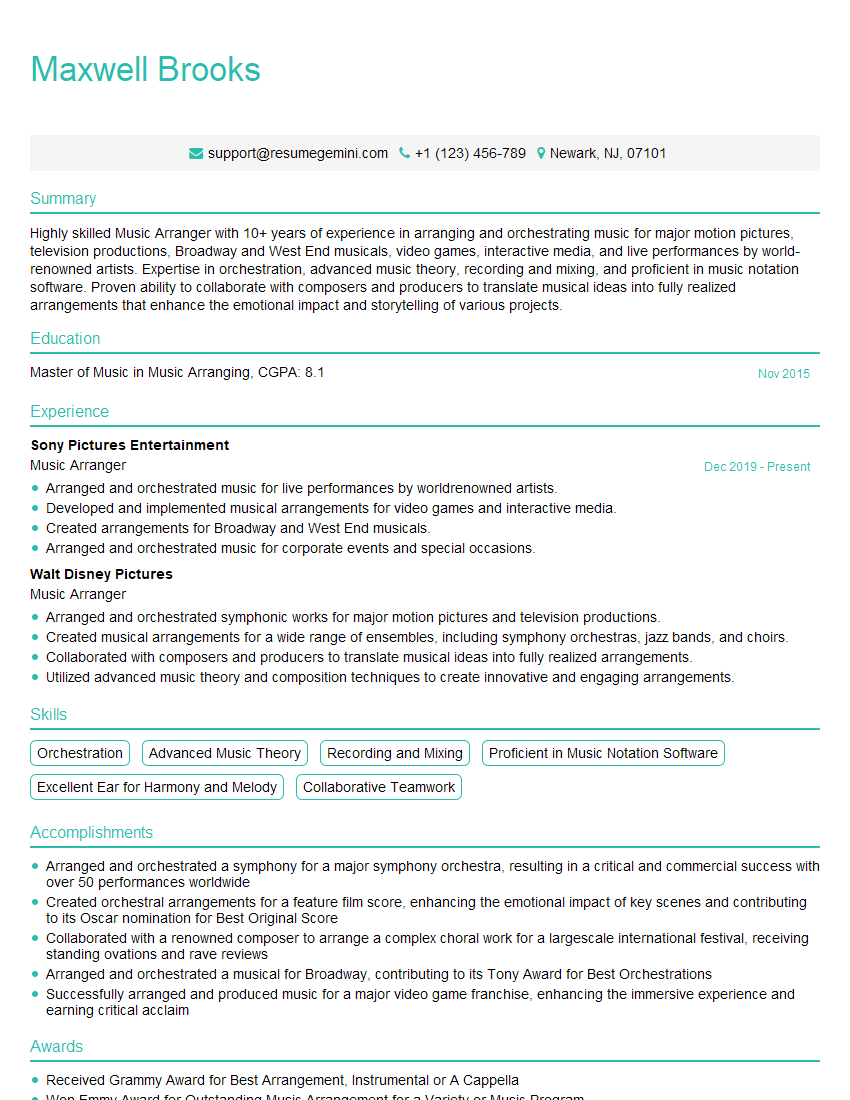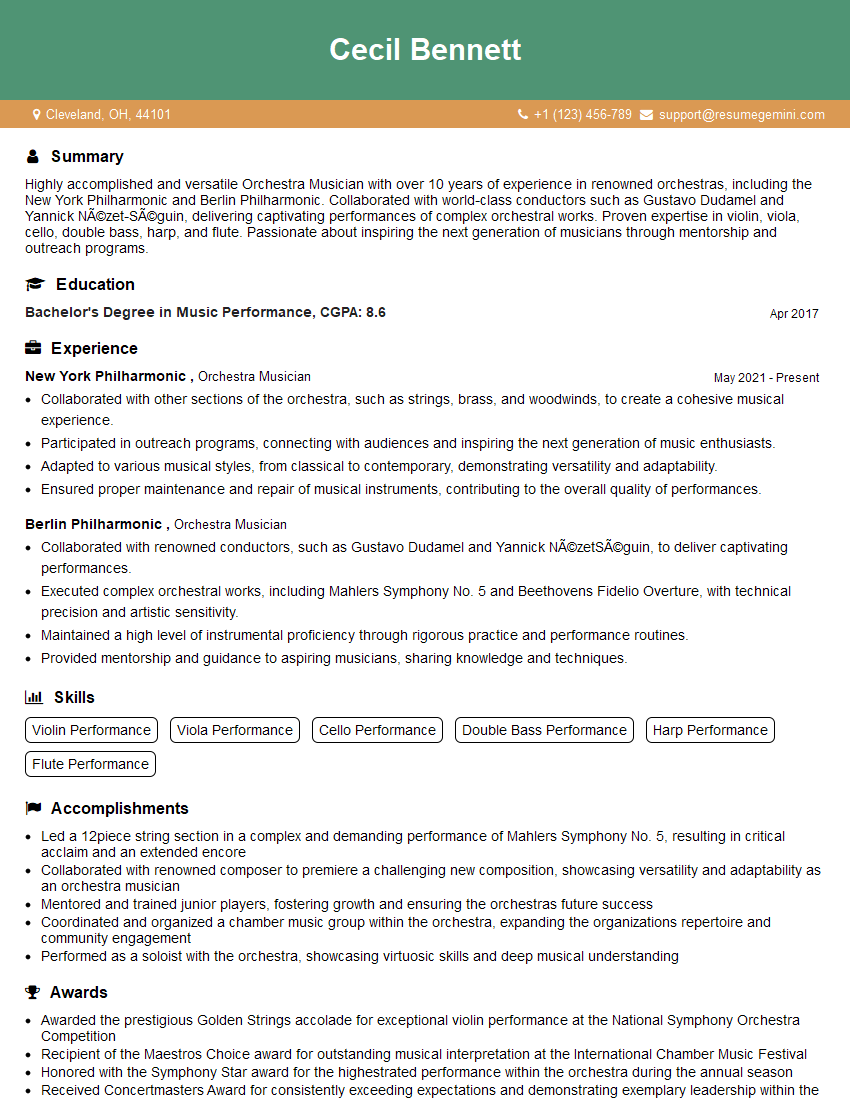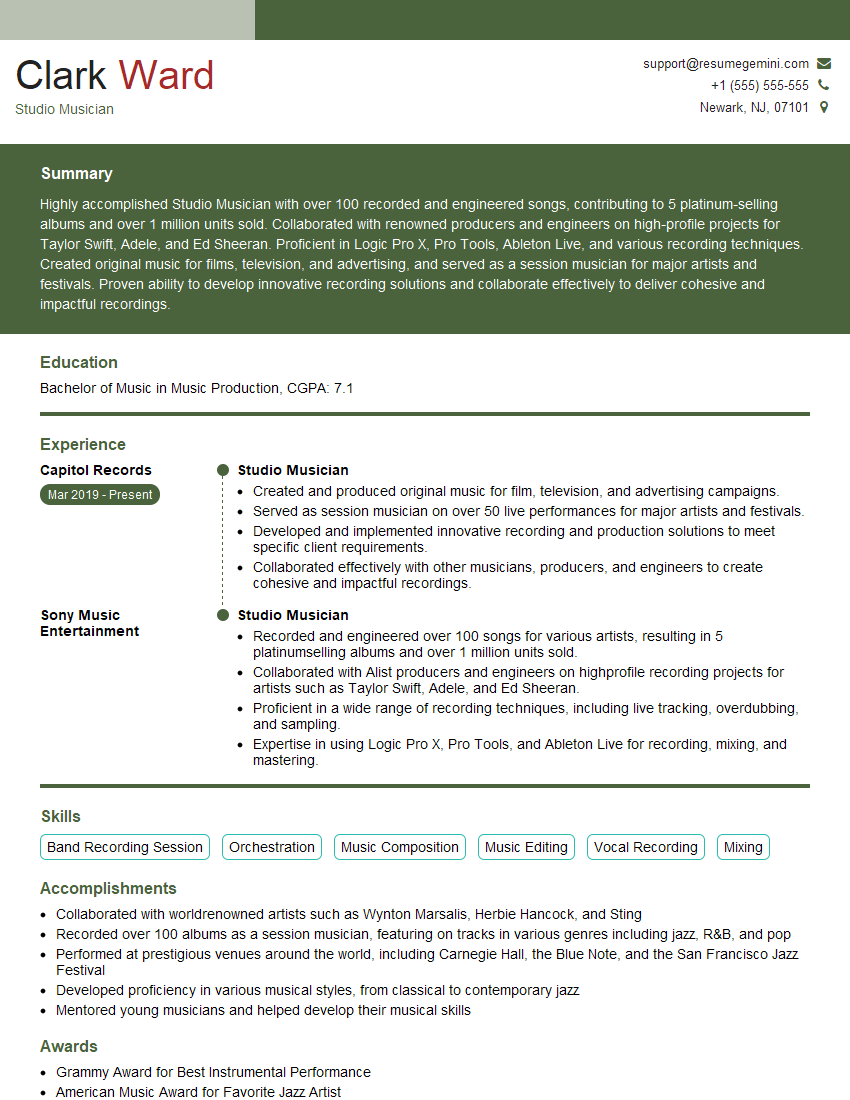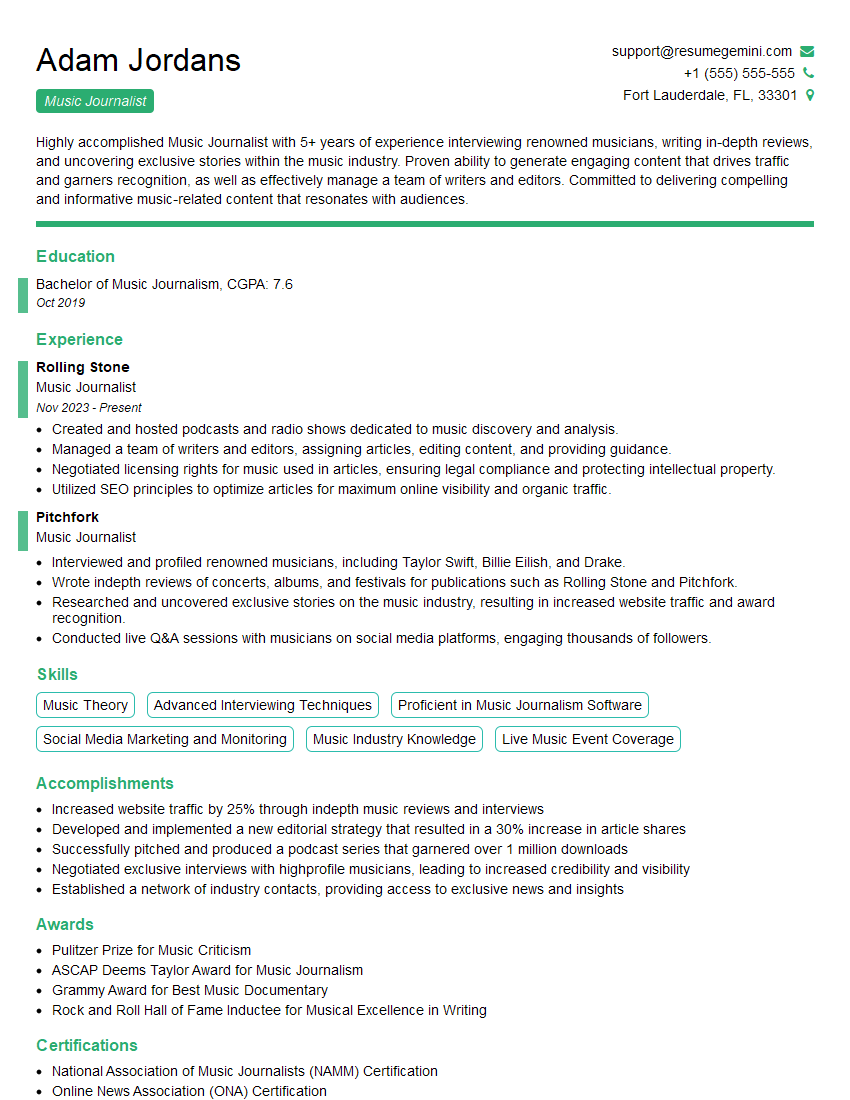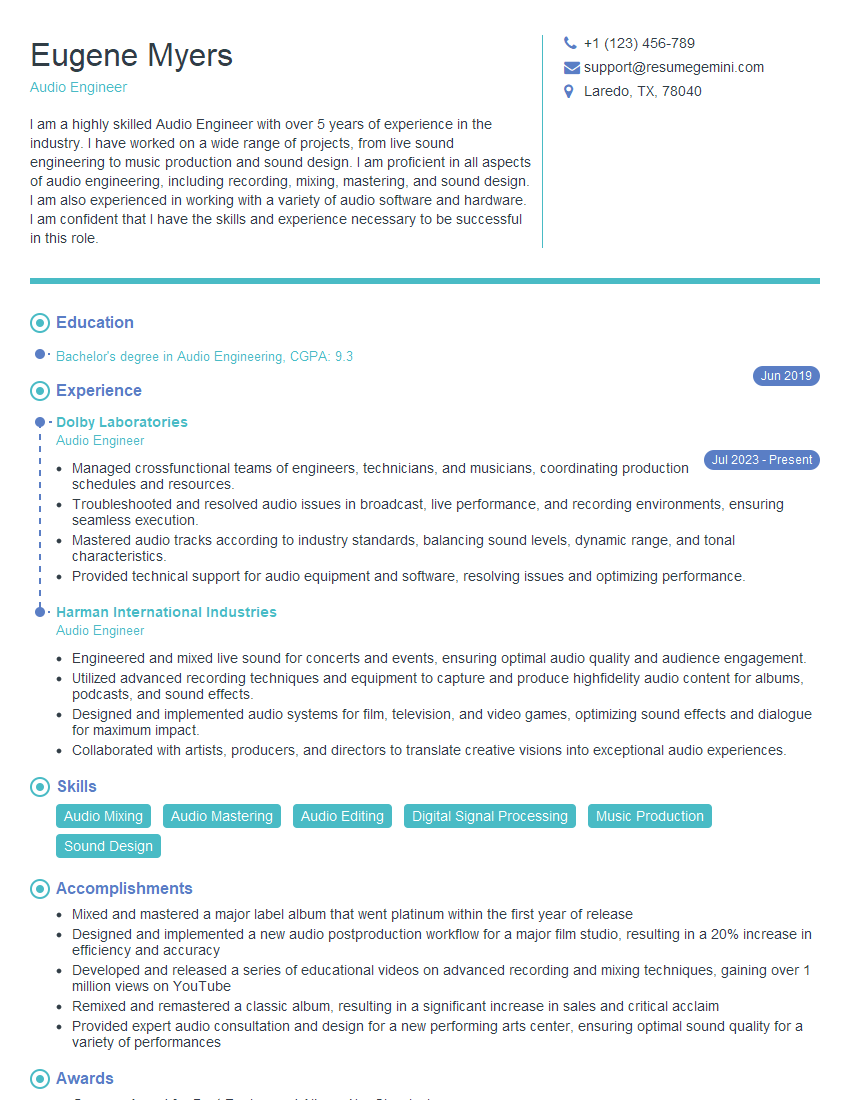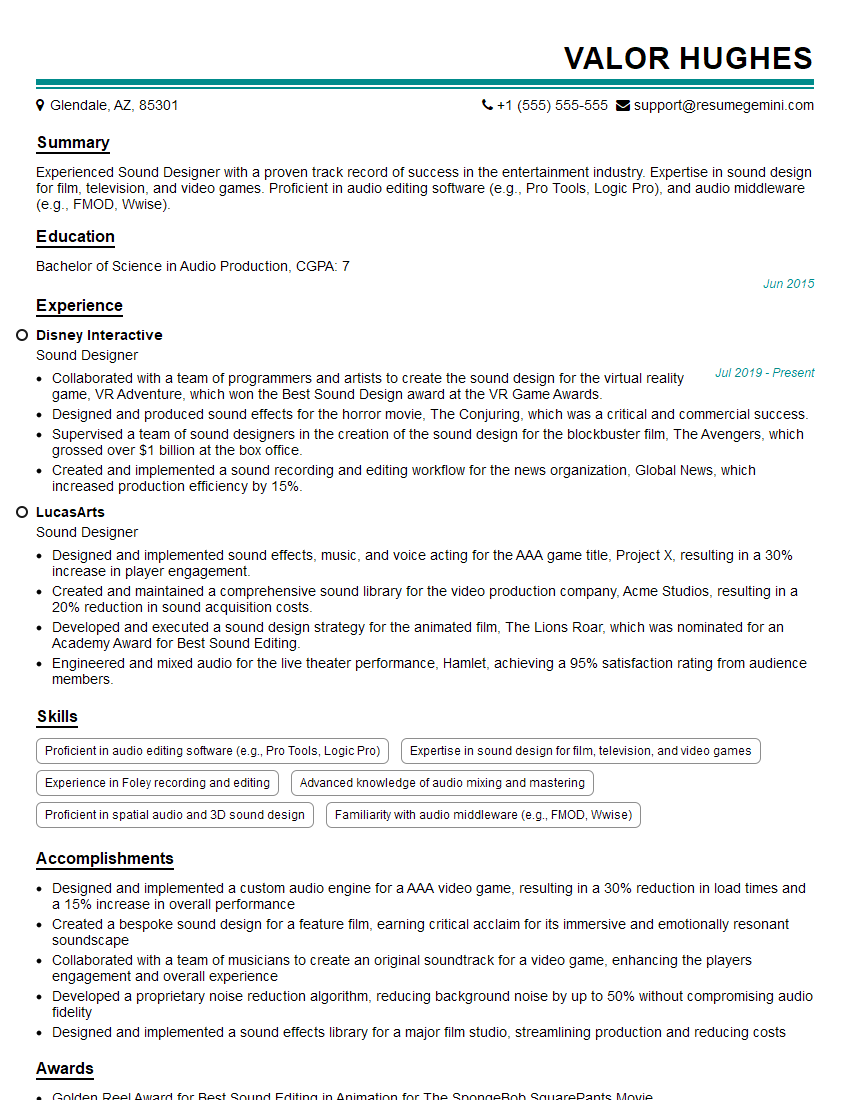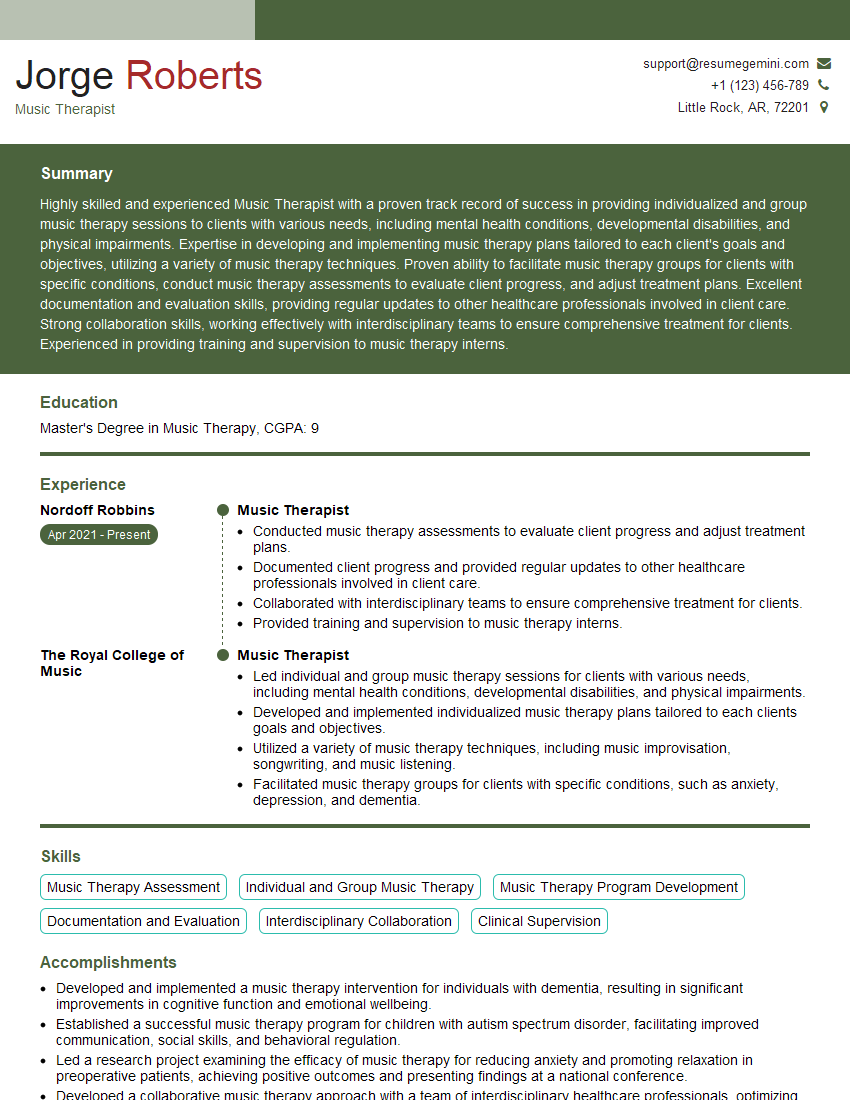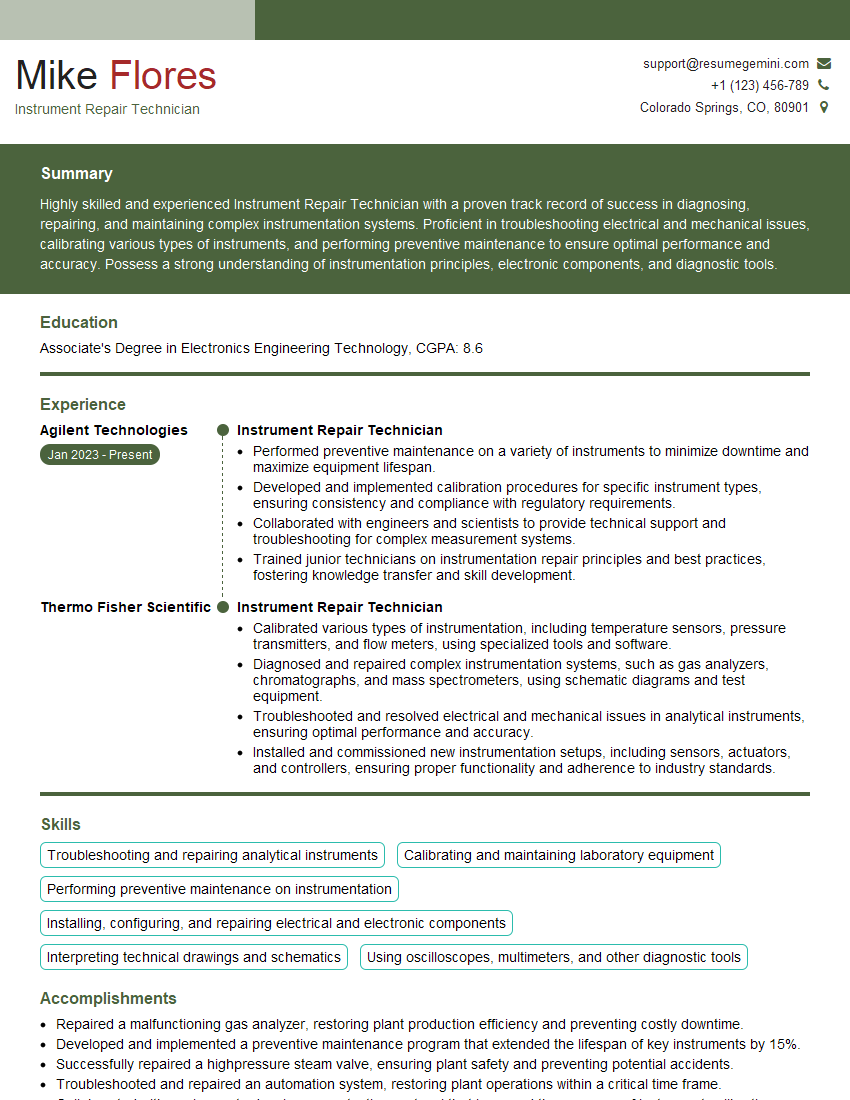Feeling uncertain about what to expect in your upcoming interview? We’ve got you covered! This blog highlights the most important Playing a musical instrument interview questions and provides actionable advice to help you stand out as the ideal candidate. Let’s pave the way for your success.
Questions Asked in Playing a musical instrument Interview
Q 1. Explain the difference between major and minor scales.
Major and minor scales are the foundational building blocks of Western music, differing primarily in their characteristic sound and emotional impact. A major scale sounds bright, happy, and uplifting, while a minor scale tends to evoke feelings of sadness, melancholy, or mystery. This difference boils down to the intervals between the notes.
A major scale is built using the formula: whole step, whole step, half step, whole step, whole step, whole step, half step (W-W-H-W-W-W-H). For example, the C major scale is C-D-E-F-G-A-B-C. Notice the intervals between the notes.
A natural minor scale uses a slightly different formula: whole step, half step, whole step, whole step, half step, whole step, whole step (W-H-W-W-H-W-W). The A natural minor scale, for instance, is A-B-C-D-E-F-G-A. There are also harmonic and melodic minor scales, which alter the intervals slightly to create different melodic effects, particularly in the ascent and descent of the scale.
The difference in the intervallic structure between a major and a minor scale drastically alters the overall feeling and harmonic possibilities of a piece of music. Imagine a simple melody played in C major versus C minor; the emotional impact is dramatically changed.
Q 2. Describe your experience with sight-reading music.
Sight-reading – the ability to interpret and play music from notation without prior preparation – is a crucial skill for any musician. My experience with sight-reading is extensive, spanning many years of practice and performance. I’ve developed this skill through consistent, dedicated practice. It’s not something that happens overnight.
I approach sight-reading systematically. First, I scan the piece to get a general sense of its structure, tempo, and key. Then, I look for familiar patterns, rhythmic groupings, and harmonic progressions. I begin slowly and focus on accuracy over speed, gradually increasing tempo as my confidence grows. Regular practice with diverse musical styles and levels of complexity is key to improving sight-reading proficiency. The more you read, the better you become at it.
I regularly challenge myself with unfamiliar pieces, focusing on understanding the harmonic structure and melodic contours rather than just playing the notes. This has allowed me to develop a strong sense of musical intuition, which helps significantly when facing unknown musical passages.
Q 3. How do you handle performance anxiety?
Performance anxiety is a common challenge for musicians, and I’ve learned various strategies to manage it effectively. Preparation is paramount. Thorough practice, ensuring a strong command of the piece, drastically reduces anxiety. I also engage in relaxation techniques such as deep breathing and mindfulness exercises before performances.
Visualization is another helpful technique. I mentally rehearse the performance several times, anticipating potential challenges and visualizing a successful outcome. Focusing on the joy of making music, rather than the pressure of the performance, helps shift my perspective.
Additionally, I find that engaging in regular physical activity and maintaining a healthy lifestyle contributes significantly to reducing overall stress levels, indirectly benefiting my ability to manage performance anxiety. Building positive performance experiences over time also bolsters my confidence and helps me manage anxiety more effectively in future performances.
Q 4. What is your preferred method for practicing scales and arpeggios?
My preferred method for practicing scales and arpeggios is multifaceted and emphasizes both technical proficiency and musical expression. I avoid rote repetition; instead, I focus on variation.
I start with slow, deliberate practice, ensuring accuracy and evenness of tone. Then, I gradually increase speed, while maintaining precision. I incorporate different articulations (e.g., legato, staccato), dynamics (e.g., crescendo, diminuendo), and rhythms to make the practice engaging and musically stimulating. I also practice scales and arpeggios in different contexts, incorporating them into etudes or improvisational exercises.
Furthermore, I use different fingerings to improve flexibility and dexterity. Regularly transposing scales and arpeggios to different keys enhances my understanding of music theory and improves my overall musical understanding. The goal isn’t just technical proficiency, but to internalize the scales and arpeggios so they become a natural extension of my musical vocabulary.
Q 5. Describe your approach to learning a new piece of music.
My approach to learning a new piece involves a structured, multi-stage process. It begins with a careful reading of the score, paying close attention to the composer’s markings (dynamics, tempo, articulation) and overall structure.
Next, I break the piece into smaller, manageable sections, focusing on mastering each section individually before combining them. I work on technical challenges (difficult passages, complex rhythms) separately, then integrate them into the larger context of the piece. I listen to recordings of other musicians performing the piece, but I avoid direct imitation; rather, I focus on understanding different interpretive approaches and finding my own expression.
Throughout the learning process, I incorporate regular practice sessions focused on different aspects of the piece—technical mastery, musical phrasing, and expressive interpretation. Regular feedback from a teacher or mentor is invaluable, offering insights into areas needing further refinement. The process isn’t just about memorizing notes, but about understanding the emotional and musical narrative of the composition.
Q 6. What software or technology do you use for music production or notation?
For music production and notation, I utilize a combination of software and technology. For notation, I primarily use Sibelius, which provides a powerful and intuitive environment for creating and editing scores. Its advanced features, such as engraving options and score-checking tools, are invaluable for creating professional-quality scores.
For audio production, I often work with Ableton Live, a digital audio workstation (DAW) that allows me to record, edit, mix, and master audio. Ableton’s flexible workflow and vast library of virtual instruments and effects are particularly useful for creating and arranging music. I also use various plugins to enhance sound quality and add special effects.
The combination of notation software and DAWs allows me to create a fully realized musical project, from initial composition to final production, with a high level of control and precision. These tools are integral to my creative workflow.
Q 7. Explain your understanding of musical dynamics and articulation.
Musical dynamics and articulation are essential elements shaping the expressive character of a musical performance. Dynamics refer to the loudness and softness of the music, while articulation refers to how notes are played or sung—their attack, duration, and connection.
Dynamics are indicated by terms like pianissimo (pp, very soft), piano (p, soft), mezzo piano (mp, moderately soft), mezzo forte (mf, moderately loud), forte (f, loud), and fortissimo (ff, very loud), along with gradual changes like crescendo (gradually getting louder) and diminuendo (gradually getting softer). Dynamic contrasts add depth and emotion to a musical performance.
Articulation is indicated by symbols such as staccato (short, detached notes), legato (smooth, connected notes), accent (emphasis on a single note), and slur (connecting notes smoothly). Articulation shapes the phrasing and rhythm of a piece and greatly affects its overall interpretation and emotional impact. The careful application of dynamics and articulation is fundamental for communicating the composer’s intentions and adding personal expression to a performance.
Q 8. How do you maintain your instrument?
Maintaining a musical instrument is crucial for its longevity and optimal performance. It’s a combination of regular cleaning, preventative maintenance, and mindful handling. For example, with a woodwind instrument like a clarinet, this involves swabbing it after every use to remove moisture that can damage the wood and pads. Regularly oiling the mechanisms prevents sticking and ensures smooth operation. For a string instrument like a violin, it’s about checking the bow hair tension, cleaning the strings, and ensuring the bridge is properly aligned. Brass instruments require valve oil and cleaning of the valves and tubing. Finally, storing the instrument in a suitable case in a stable climate helps to prevent damage from temperature and humidity fluctuations.
- Regular Cleaning: This is the most important aspect. Dust, dirt, and moisture can cause significant damage. Specific cleaning methods will vary depending on the instrument.
- Preventative Maintenance: Regular checks by a qualified technician can identify potential problems early, saving money and preventing serious issues. This includes things like adjusting intonation on a string instrument, or a thorough inspection of the pads on a woodwind instrument.
- Mindful Handling: Avoid dropping or bumping your instrument. Always handle it with care to prevent dents, scratches, or damage to sensitive parts.
Q 9. Describe your experience with ensemble playing.
Ensemble playing is a cornerstone of my musical experience. I’ve participated in various ensembles, from small chamber groups to large orchestras. The collaborative aspect is incredibly rewarding. In a chamber group setting, the focus is on intricate interplay and a deep understanding of the music with fellow musicians. We worked together to create the best possible performance, offering critiques and helping each other improve. Larger ensembles demand precision and coordination. You learn to listen attentively to the other musicians, blend your sound seamlessly, and maintain a consistent tempo and dynamic balance. Learning to adapt to the performance styles of individual ensemble members is a key skill. For example, playing in a string quartet required sensitive communication and a responsiveness to the nuances of the other players’ performances.
The collaborative problem-solving involved in ensemble playing has significantly improved my musicality and ability to communicate artistically with others.
Q 10. What are your strengths and weaknesses as a musician?
As a musician, my strengths lie in my technical proficiency, my musicality, and my ability to adapt to different musical styles. I possess a solid foundation in music theory and have a good ear for pitch and rhythm. I’m also a quick learner and am able to master new pieces relatively easily. However, like any musician, I also have areas for improvement. I sometimes struggle with managing stage fright, particularly in high-pressure situations. Another area for growth is improving my ability to communicate and engage with the audience during performances. Constantly working to overcome my weaknesses is a crucial part of my ongoing musical development.
Q 11. How would you adapt your playing style for different musical genres?
Adapting my playing style to different genres requires a flexible approach and a willingness to experiment. For example, playing a classical piece necessitates a focus on precision, articulation, and a nuanced dynamic range. Playing jazz would require improvisation skills and a mastery of swing rhythm and blues scales. Rock music might demand a heavier tone, more distortion, and a powerful rhythmic drive. To adapt effectively, I analyze the genre’s stylistic characteristics, focusing on tempo, rhythm, phrasing, dynamics, and overall tone. I immerse myself in listening to music from the chosen genre to develop a feel for its specific nuances. Ultimately, the key is to understand the specific elements of each genre and to use those elements to build a cohesive and authentic performance.
Q 12. Describe a time you had to overcome a technical challenge while performing.
During a performance of a particularly challenging concerto, a section of the piece involved a rapid series of difficult arpeggios. During rehearsal, I had managed them, but under the pressure of the performance, my fingers began to falter. I felt my hands tense up. I quickly realized I needed to adjust my approach. I took a deep breath, slowed down slightly, and focused on clear finger placement and consistent rhythm. I broke down the passage into smaller, more manageable sections, focusing on accuracy and clarity rather than speed. By consciously controlling my breathing and relaxing my hands, I was able to recover and complete the passage successfully. This experience taught me the importance of maintaining composure under pressure and the need to adjust my technique to overcome unexpected difficulties during performance.
Q 13. What is your experience with improvisation?
Improvisation is a vital part of my musical practice, especially within jazz and contemporary genres. I approach improvisation by focusing on building melodic ideas upon a harmonic foundation. It’s like having a conversation with the chords. I usually start with a simple melodic idea and develop it through variations, ornamentation, and rhythmic shifts. I utilize scales, modes, and chord tones as a basis for my improvisations. Active listening is key, especially in group improvisations, adapting and responding to the contributions of other musicians. Scales such as the blues scale and pentatonic scales often serve as excellent starting points for jazz improvisations. It’s about creating something spontaneous and expressive while staying within the bounds of the harmonic structure.
Q 14. Explain your understanding of rhythm and meter.
Rhythm and meter are fundamental to music. Meter refers to the regular pulse and grouping of beats. For example, 4/4 time signature means there are four beats per measure, and the quarter note gets one beat. Rhythm is the pattern of durations of notes and rests within that meter. It’s how we organize the sound in time. Understanding these concepts is essential for accurate performance. A strong sense of rhythm and meter allows musicians to play with precision and groove. Consider the difference between a simple rhythmic pattern such as quarter note, quarter note, quarter note, quarter note and a more complex one such as dotted quarter note, eighth note, eighth note, quarter note. The latter adds rhythmic interest and complexity within the same 4/4 meter. A solid understanding of rhythm and meter is fundamental to musical expression and the ability to create compelling musical phrases.
Q 15. How would you teach a beginner to play your instrument?
Teaching a beginner to play the guitar, my chosen instrument, starts with building a solid foundation. This involves making sure they’re comfortable holding the instrument correctly, understanding basic posture, and learning proper hand positioning. We begin with simple chords, like G, C, and D, focusing on accurate finger placement and clean transitions. I emphasize consistent practice, even just 15-20 minutes a day, and encourage them to listen attentively to the sound they produce, focusing on achieving a clear and resonant tone. We’ll then gradually introduce strumming patterns and simple melodies, working on fingerpicking techniques once they grasp the basic chords and strumming.
I believe in a positive and encouraging learning environment. We’ll start with songs they already know and love, breaking them down into manageable segments. This keeps them engaged and motivated. Early success builds confidence, which is crucial for continued learning. Regular feedback and adjustments to their technique are essential throughout the process. I also encourage them to explore their own creativity and incorporate personal expression into their playing from the very beginning.
Career Expert Tips:
- Ace those interviews! Prepare effectively by reviewing the Top 50 Most Common Interview Questions on ResumeGemini.
- Navigate your job search with confidence! Explore a wide range of Career Tips on ResumeGemini. Learn about common challenges and recommendations to overcome them.
- Craft the perfect resume! Master the Art of Resume Writing with ResumeGemini’s guide. Showcase your unique qualifications and achievements effectively.
- Don’t miss out on holiday savings! Build your dream resume with ResumeGemini’s ATS optimized templates.
Q 16. Describe your experience with music theory.
My understanding of music theory is extensive, spanning years of formal study and practical application. I’m proficient in reading and writing music notation, including understanding rhythm, melody, harmony, and counterpoint. I can analyze musical pieces to identify their structure, key signatures, chord progressions, and melodic motifs. This knowledge allows me to compose my own music, arrange pieces for different instruments, and improvise effectively across various musical styles. I understand different scales and modes and their impact on the overall mood and character of a musical piece.
For example, I can quickly identify a piece written in Dorian mode because of its characteristic minor feel but with a major third interval. This understanding allows me to contribute effectively in group compositions and improvise using the appropriate scales and chords. I actively use this theoretical knowledge to teach others, translating complex concepts into readily understandable language.
Q 17. What is your preferred method for tuning your instrument?
My preferred method for tuning my guitar is using a combination of a digital tuner and my ear. While a digital tuner provides accurate and quick tuning, relying solely on it can hinder the development of good pitch recognition. Therefore, I frequently use a digital tuner to get close to the correct pitch, and then fine-tune each string using my ear. This allows me to develop an ‘internal tuner’, enhancing my ability to play in tune without relying on external devices. This is especially crucial when performing live, where a digital tuner might not always be practical.
The process involves tuning the sixth string (E) to its correct pitch, and then using that as a reference to tune the rest of the strings using the intervals between them. I listen carefully to each string, adjusting until I perceive the perfect consonance with its adjacent strings. This combination of technology and ear training ensures a highly accurate and precise tuning.
Q 18. What types of music do you enjoy playing and why?
I enjoy playing a wide range of music, but I particularly gravitate towards blues, jazz, and folk music. The blues appeals to me because of its emotional depth and expressive phrasing. The improvisation inherent in jazz allows for a constant exploration and reinvention of musical ideas. The simplicity and storytelling nature of folk music offers a satisfying contrast. These genres allow for great emotional expression through both technical skill and creative interpretation.
For example, the blues’ use of bent notes and vibrato, combined with the specific rhythmic patterns, creates a rich sonic palette. Similarly, the complex harmonic structures of jazz and the storytelling traditions of folk music provide a different type of challenge and reward. I find the blend of emotional resonance and creative exploration deeply fulfilling.
Q 19. How do you stay up-to-date on current musical trends?
Staying current with musical trends involves a multifaceted approach. I regularly listen to a wide variety of artists and genres through streaming services and radio. I also attend live performances, festivals, and concerts to experience music in a live setting. Following musical publications, blogs, and social media accounts dedicated to different genres broadens my awareness of new artists and emerging styles. Engaging in online music communities and forums allows me to share ideas and learn from others’ experiences.
For instance, attending a local music festival exposes me to lesser-known artists who might be pioneering new sounds. Similarly, reading articles and reviews helps me understand the critical reception and broader impact of new releases. This well-rounded approach ensures I remain abreast of both popular and niche musical trends.
Q 20. Describe your experience with different musical styles.
My experience spans various musical styles, including classical, rock, pop, country, and world music. This diverse background has honed my adaptability and expanded my musical vocabulary. Each style presents unique challenges and rewards. For instance, the precision and technical demands of classical music differ significantly from the energetic improvisation of rock music. Understanding the nuances of each genre enhances my ability to approach any musical challenge effectively and creatively.
Learning classical guitar, for instance, deeply informed my technique and understanding of music theory, while playing in a rock band taught me the value of dynamics, stage presence, and collaboration in a high-energy setting. This broad exposure allows for a richer understanding and creative expression in diverse musical contexts.
Q 21. How do you approach collaborating with other musicians?
Collaborating with other musicians is a crucial part of my musical journey. I approach such collaborations with a mindset of mutual respect, open communication, and a willingness to compromise. I believe active listening is vital; truly hearing what other musicians are contributing is critical for creating cohesive and compelling music. Before starting a collaboration, I discuss the project’s goals, style, and individual roles to ensure everyone is on the same page. Effective communication is essential to resolve any creative differences that may arise during the process.
I value everyone’s input and strive to create an atmosphere where everyone feels comfortable sharing their ideas. This approach fosters creativity and allows for the development of something truly unique and greater than the sum of its parts. Respecting the individual strengths of each musician allows for a dynamic and enriching musical experience.
Q 22. Explain your understanding of harmony and counterpoint.
Harmony and counterpoint are fundamental concepts in music composition and theory. Harmony refers to the simultaneous sounding of notes, creating chords and progressions that evoke specific emotions and moods. Counterpoint, on the other hand, involves the combination of independent melodic lines that interact and complement each other. Think of it like a conversation between different voices.
Harmony involves understanding chord structures (major, minor, diminished, augmented), chord progressions (sequences of chords), and voice leading (how individual notes move smoothly between chords). A simple example is a I-IV-V-I progression in C major (C-F-G-C), a common and pleasing harmonic progression.
Counterpoint, conversely, focuses on the independent melodic lines. Strict counterpoint, often found in Baroque music, follows specific rules regarding melodic intervals and voice leading to maintain clarity and avoid clashes. For example, two voices might move in contrary motion (one ascending while the other descends) or parallel motion (both ascending or descending) to create interesting textures. Less strict counterpoint allows for more freedom and complexity.
Understanding both harmony and counterpoint is crucial for composing, arranging, and even performing music effectively. A skilled musician can analyze a piece’s harmonic structure and identify the contrapuntal interplay between different melodic lines, leading to a deeper understanding and appreciation of the music.
Q 23. What is your experience with recording and editing music?
My experience with music recording and editing spans over a decade. I’m proficient in using Digital Audio Workstations (DAWs) such as Logic Pro X, Ableton Live, and Pro Tools. My work includes recording various instruments, both solo and ensemble performances. This includes meticulous microphone placement to capture the nuances of different instruments, and I am familiar with various mixing and mastering techniques. I understand the importance of signal processing, using equalizers (EQ), compressors, reverbs, and delays to shape the sound and achieve the desired aesthetic.
Beyond technical skills, I value the artistic aspect of recording. I believe that the recording process should enhance, not detract from, the musical performance. My approach is collaborative; I work closely with artists to achieve their musical vision and bring their ideas to life. I have also experience with editing audio, including cleaning up unwanted noises, editing individual tracks, and aligning multiple takes for a polished final product.
Q 24. Describe your process for preparing for a performance.
Preparing for a performance is a multi-stage process involving physical and mental aspects. It begins weeks, sometimes months, in advance, depending on the complexity of the piece. Firstly, I thoroughly learn the music, focusing on technical accuracy and musical expression. This involves practicing individual sections, then piecing them together. Regular practice sessions, often broken into shorter, focused segments, are key to build endurance and refine my technique.
Secondly, I incorporate mental rehearsal into my practice. This involves visualizing the performance, focusing on posture, breathing, and any potential challenges. I also consider the acoustics of the venue, adjusting my playing style and dynamics accordingly. Finally, a thorough warm-up routine is crucial before any performance to prepare my body and mind. This includes physical stretches and playing scales and arpeggios to improve dexterity and focus. It’s a holistic process, and attention to detail at each stage significantly affects the performance’s quality.
Q 25. How do you handle constructive criticism?
Constructive criticism is invaluable for growth. I actively seek it out and view it as an opportunity to improve. My approach is to listen attentively, ask clarifying questions to fully understand the feedback, and then reflect on how to incorporate the suggestions into my playing. I avoid becoming defensive and instead focus on identifying the specific areas where improvement is needed.
For instance, if I receive criticism about my tone being inconsistent, I’ll analyze my technique, perhaps focusing on my embouchure or bowing technique. I might record myself to identify patterns or seek advice from trusted mentors or colleagues. The goal is not perfection but continuous improvement, and feedback plays a crucial role in that journey. I believe that embracing constructive criticism with a growth mindset is essential for any musician.
Q 26. What are your career goals as a musician?
My career goals are multifaceted. On a short-term basis, I aim to expand my performance opportunities by collaborating with different musicians and ensembles. This includes seeking out diverse genres and pushing my creative boundaries. In the long-term, I aspire to establish myself as a respected solo performer and recording artist. I envision composing original music and sharing my skills through teaching and mentoring aspiring musicians. My ultimate goal is to contribute to the musical landscape through my creative expression and educational endeavors.
Q 27. How do you manage your time effectively while practicing and performing?
Effective time management is crucial in the demanding world of music. I utilize a combination of planning tools and strategies. A detailed weekly schedule helps me allocate specific time slots for practice, performances, and other musical activities. I break down large tasks into smaller, manageable chunks to avoid feeling overwhelmed. The Pomodoro Technique, involving focused bursts of work followed by short breaks, helps me maintain focus and prevent burnout.
I prioritize tasks based on their urgency and importance, ensuring that important performance preparations receive the necessary attention. Additionally, I maintain a balance between structured practice and creative exploration. This allows me to maintain technique while staying inspired and developing my artistic voice. Effective time management is an ongoing process of adaptation and refinement.
Q 28. Describe a time you had to adapt to a challenging musical situation.
During a recent performance, the pianist unexpectedly fell ill just hours before the concert. As a collaborative ensemble, we faced a serious challenge. We quickly brainstormed solutions, considering alternatives such as postponing or canceling the concert. However, given the audience’s expectations and the extensive preparation that had gone into the performance, we decided to proceed. I, along with the other instrumentalists, rehearsed the pianist’s parts, coordinating our efforts to compensate for their absence.
This required a significant amount of flexibility and adaptation. We simplified certain passages to maintain musical coherence while ensuring the performance remained engaging. It was a demanding situation requiring quick thinking and adaptability. Despite the unexpected challenges, the performance was well-received, demonstrating our ability to adapt and overcome unforeseen circumstances. It highlighted the importance of teamwork and the ability to remain resourceful under pressure.
Key Topics to Learn for Playing a Musical Instrument Interview
- Instrument-Specific Techniques: Mastering scales, chords, arpeggios, and other fundamental techniques relevant to your chosen instrument. Consider showcasing your understanding of advanced techniques you’ve explored.
- Music Theory Fundamentals: Demonstrate a solid grasp of rhythm, melody, harmony, and form. Be prepared to discuss key signatures, time signatures, and common musical notation.
- Performance Practice: Discuss your approach to practicing, including methods for improving technique, memorization strategies, and overcoming performance anxiety. Highlight your ability to adapt to different performance settings.
- Aural Skills: Show your ability to recognize intervals, chords, and melodies by ear. Discuss your experience with sight-reading and improvisation.
- Musical Styles and Genres: Discuss your familiarity with various musical styles and your ability to adapt your playing to different genres. Highlight any specialized knowledge in a particular area.
- Ensemble Experience: Detail your experience playing in ensembles (bands, orchestras, chamber groups), highlighting your collaborative skills and contributions to group performance.
- Problem-Solving and Adaptability: Be ready to discuss instances where you encountered challenges in your musical journey and how you overcame them. This demonstrates resilience and a growth mindset.
- Teaching and Mentoring (If Applicable): If you have experience teaching or mentoring others in music, be prepared to discuss your approach and successes.
Next Steps
Mastering a musical instrument demonstrates dedication, discipline, and a commitment to excellence—qualities highly valued in many professional fields. Highlighting these skills on a well-crafted resume can significantly boost your job prospects. To ensure your resume effectively showcases your abilities to Applicant Tracking Systems (ATS), focus on using keywords relevant to the specific jobs you’re targeting. ResumeGemini is a trusted resource for creating professional and ATS-friendly resumes. They offer examples of resumes tailored to Playing a musical instrument, helping you present your skills and experience in the best possible light.
Explore more articles
Users Rating of Our Blogs
Share Your Experience
We value your feedback! Please rate our content and share your thoughts (optional).
What Readers Say About Our Blog
Hello,
We found issues with your domain’s email setup that may be sending your messages to spam or blocking them completely. InboxShield Mini shows you how to fix it in minutes — no tech skills required.
Scan your domain now for details: https://inboxshield-mini.com/
— Adam @ InboxShield Mini
Reply STOP to unsubscribe
Hi, are you owner of interviewgemini.com? What if I told you I could help you find extra time in your schedule, reconnect with leads you didn’t even realize you missed, and bring in more “I want to work with you” conversations, without increasing your ad spend or hiring a full-time employee?
All with a flexible, budget-friendly service that could easily pay for itself. Sounds good?
Would it be nice to jump on a quick 10-minute call so I can show you exactly how we make this work?
Best,
Hapei
Marketing Director
Hey, I know you’re the owner of interviewgemini.com. I’ll be quick.
Fundraising for your business is tough and time-consuming. We make it easier by guaranteeing two private investor meetings each month, for six months. No demos, no pitch events – just direct introductions to active investors matched to your startup.
If youR17;re raising, this could help you build real momentum. Want me to send more info?
Hi, I represent an SEO company that specialises in getting you AI citations and higher rankings on Google. I’d like to offer you a 100% free SEO audit for your website. Would you be interested?
Hi, I represent an SEO company that specialises in getting you AI citations and higher rankings on Google. I’d like to offer you a 100% free SEO audit for your website. Would you be interested?
good
